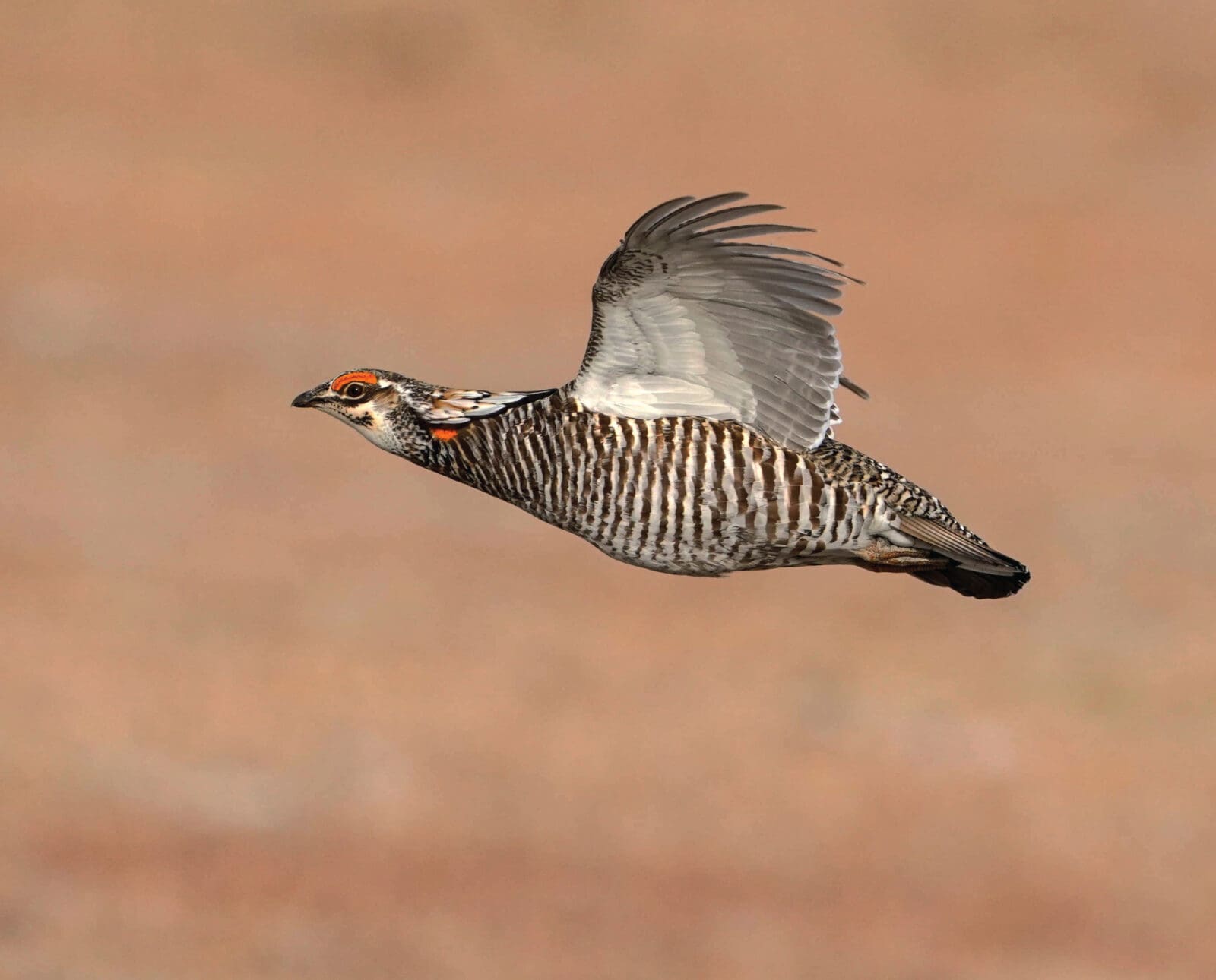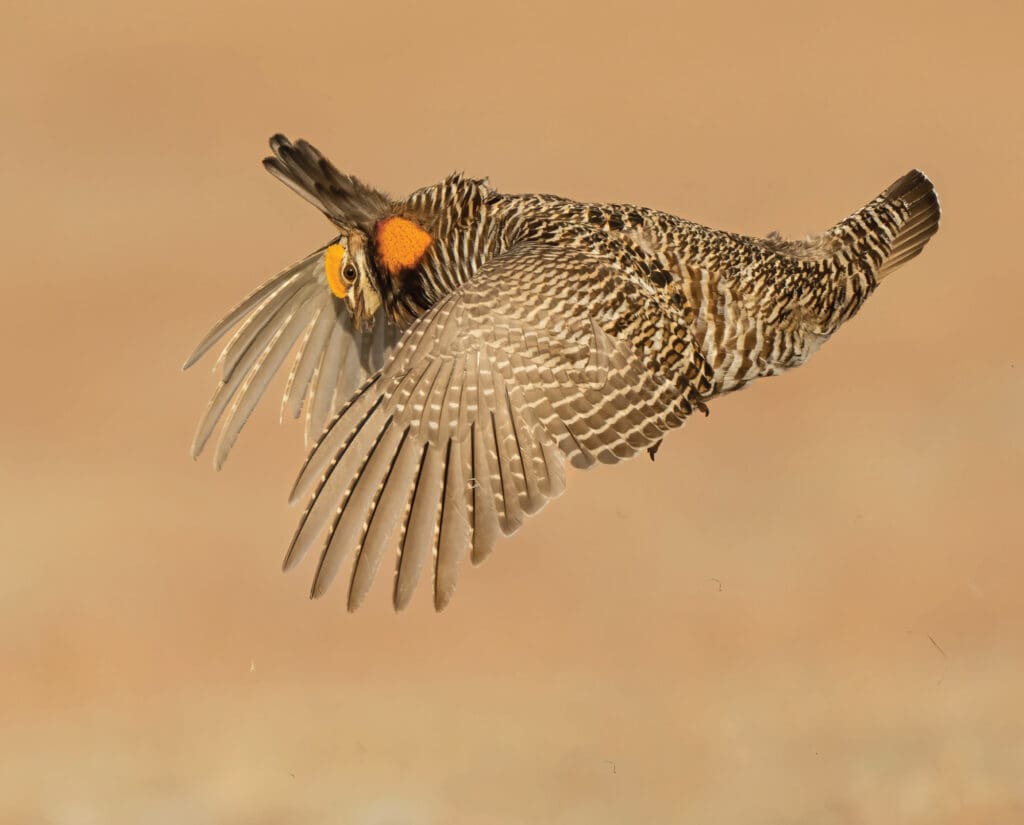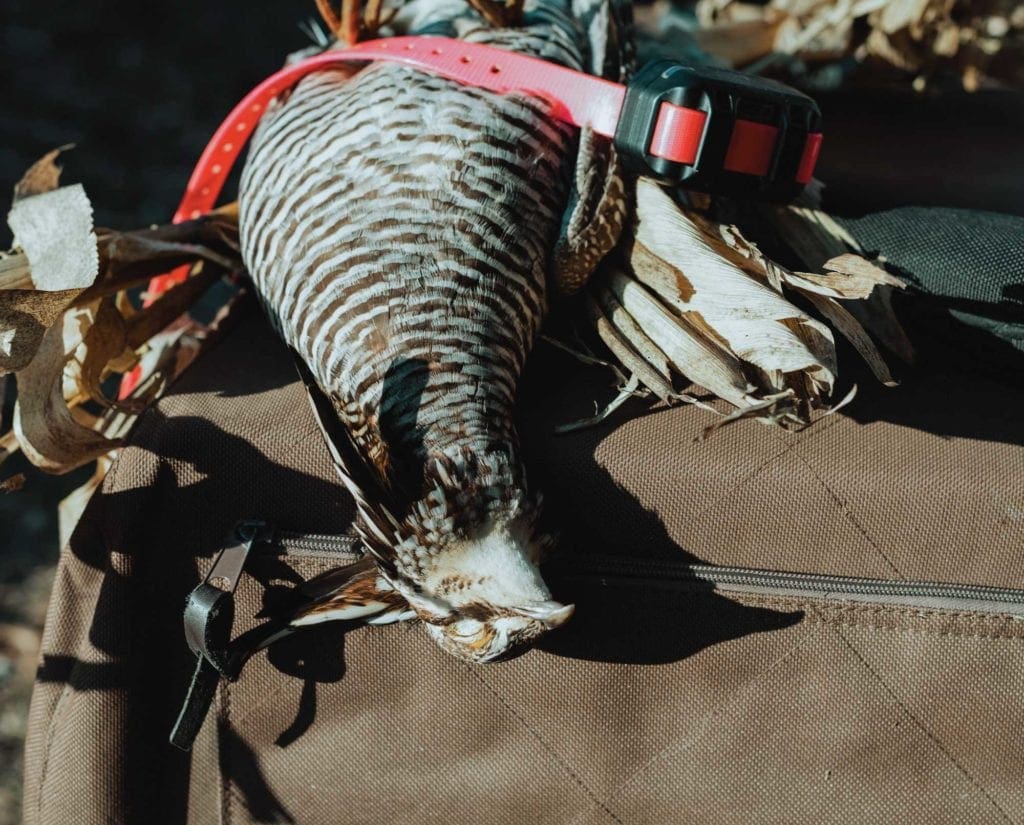Home » Grouse Species » Prairie Chicken Hunting » Guide to Hunting Greater Prairie Chickens
Guide to Hunting Greater Prairie Chickens

Frank Loncarich has been a wildlife biologist for over 20…
Prairie chicken hunting tips, tricks, and advice from an expert
After 35 years of bird hunting, I have been fortunate enough to harvest nearly 90 percent of the readily huntable gamebird species in the lower 48 (please don’t @ me, Himalayan snowcock hunters). While each species is special, one bird in particular holds a special place in my heart, a bird I hold above all others: the greater prairie chicken.
Listen to more articles on Apple | Google | Spotify | Audible
A lot of this comes from studying prairie chickens in the Kansas Flint Hills for my Masters degree. I also spent seven years trapping and translocating greater prairie chickens for my job as a wildlife biologist. But there’s more to it than that; the bird itself is something of an enigma. They are actively retreating from their original strongholds of Illinois, Missouri, and Iowa and making a stand in the far western fringe of their once vast range. In these fringes, they eschew trees and humans. It seems like they just want to be left alone.
Despite their preference for remote areas, hunters flock to the grasslands of Kansas, Nebraska, and South Dakota every September for the early prairie grouse season. This can be a challenging time to hunt. The weather is warm, the grasslands are vast, and it can be difficult for dog or man to pinpoint precisely where to start looking. During my decades of research and hunting, I have picked up a few pointers that might help make your next prairie chicken hunt more successful.

Locating and Hunting Greater Prairie Chicken Leks
Videos of displaying and booming, or calling, greater prairie chickens are common. In these videos, males are on their spring breeding grounds, which are called leks. The lek is the center of prairie chicken social dynamics and is visited nearly every day of the year by some birds, except during the heart of summer. Males gather at these leks to maintain order and socialize during the non-breeding season. There is a noticeable uptick in lek use during the fall.
Adult male prairie chickens will visit leks first thing on fall mornings, and there may even be some limited displaying, fighting, and characteristic booming. Hunters can undoubtedly use this information to their advantage. But how does one locate a lek?
If you live near your hunting area, the easiest way to find leks is to drive around and listen for displaying birds in the spring, mark lek locations, and then ask for permission to hunt later in the year if the lek is on private land. If you must travel to hunt birds, look for high spots on ridge tops or areas of low-cropped vegetation or bare dirt. Males want to be seen and heard, so they often display on the highest points in a landscape. Due to thin soils, these areas often have short vegetation anyway, making them doubly attractive.
Look for places around stock tanks, ponds, or prairie dog towns in flat country. You can remotely scout for these areas using aerial photography.
When you arrive at a potential lek site, it will be evident if birds are using them. Fresh prairie chicken scat and scattered feathers are dead giveaways. You might even find tracks in soft dirt on the tops of prairie dog mounds.
I have tried to hunt leks first thing in the morning when birds use them with little luck. Typically, the vegetation is so short that the birds see you coming well in advance, and getting close for a shot is tricky. Don’t fret, though. In the early fall, these birds usually land in taller vegetation only a few hundred yards away. Just give them a little time to settle down, drop your pup, hunt into the wind, and get after them.
My preferred way to hunt leks is to arrive around 9 a.m. when the birds have had enough time to sort things out on the lek and move off into the surrounding vegetation. Then, I hunt ever-larger circles around the lek until I find birds. Over the years, I have developed a “milk run” of leks that I can hunt throughout the day, and I’ll generally find birds around one or more by the end of the hunt. This is a key way to reduce your search time when hunting the vast grasslands. Walking randomly across the prairie might yield some birds, especially in good population years. But locating and hunting near leks is a much better option.

Hunt Near Agriculture
Greater prairie chickens thrived on America’s grasslands long before humans settled them and began to grow agricultural products, feeding on various native seeds and insects. They still do that in many places. That said, they are not opposed to dining on “man-made” food, especially if the food is close to native grass cover.
One crop they relish is alfalfa. The combination of green, moisture-filled leaves and the millions of invertebrates attracted to it draws birds from a wide range, especially hens with broods. Young prairie chickens need high-protein insects to grow quickly before winter. Hunting green alfalfa near native prairie has paid off well for me.
Another highly preferred prairie chicken food is soybeans. Prairie chickens will fly long distances to feed in soybean fields during the winter, but soybeans are also utilized late in the early hunting season. I remember one mid-October hunt where I struggled to find birds in my typical spots. Finally, I hunted a pasture near an unharvested soybean field and began to find birds near the edge of the soybeans. Sure enough, the birds had soybeans in their crop, so I began to hunt similar spots, turning my hunt around.
Choosing Shot Size and Shotgun Chokes
Prairie chickens are relatively easy to bring down and rarely run when just winged. Therefore, an improved cylinder or modified choked 20 gauge with #6 shot is a fine choice for early-season work. However, because adult prairie chickens often flush at 30-40 yards from the hunter, I prefer the extra confidence that comes with 12 gauge throwing #6 or #7.5 shot from an improved cylinder or modified shotgun chokes. I have had to make some rangy shots later in the fall season and have come to rely on my 12 gauge.
Dog Work Tips
Early-season prairie chicken hunting seasons are designed for pointing dog work. Young-of-the-year birds often hold well for a dog, while adult birds are hit or miss. This rarely happens during the late prairie chicken season when birds are in large flocks, so the early season provides some of the only real dog work you might see while hunting this species. Any pointing breed will work. I’ve successfully hunted behind setters, Brittanys, and German Shorthair Pointers.
Remember to watch for your dog to “high-head” scented prairie chickens. This means they’ve caught the scent of birds at a distance and will briefly stop with their head held high. With adult prairie chickens, this might be the closest you get to a real point before birds flush at 30 yards. Your shot availability might be low if you’re a stickler for well-handled birds.

Additional Prairie Chicken Hunting Tips
One key to remember is that prairie chickens do not like tall grasses. You normally won’t find them in tall CRP fields unless those fields have been subject to grazing or drought. Pheasants have ruined us on thinking game birds like tall, thick grass vegetation. Most of them don’t, and prairie chickens are no exception. This is usually not a problem on grazed native prairies. However, some years with heavy rainfall result in tall, thick grass on the prairies. I had to look for shorter vegetation that had been significantly grazed before I found any birds.
Another key tip is to be aware of the wind. Winds nearly always blow on the plains, and the birds are adapted to it. A mild 10-15 mph wind usually doesn’t affect birds, but one 20 mph will cause birds to seek out the lee sides of hills for shelter. When hunting those conditions, make sure to slip over hills onto the lee side, and you’ll frequently catch birds napping and in range for a shot.
Here’s another tip that has helped put an extra bird or two in my pocket over the years. Prairie chickens tend to flush in a “popcorn” manner. This means that not all the birds in a group, no matter how small, flush as one like Hungarian partridge or bobwhites. Some often will stay put while others beat it for the other side of the hill. When a group flushes wild, and I cannot stress this enough, always hustle (do not run with a loaded gun) to the flush spot. Often, a bird or two will let you get in range before flushing.
Where to Go to Hunt Prairie Chickens
For decades, the Flint Hills of Kansas had been a destination for greater prairie chicken hunters. Sadly, those once robust populations have declined significantly due to a change in grazing practices where annual burning is the norm and leaves minimal nesting cover over vast areas. Coupled with very little public land, I would steer most prairie chicken hunters away from the Flint Hills. However, very nice populations of greater prairie chickens can be found in the Smoky Hills of north-central Kansas. Birds can be found in the mixed grasslands and agricultural landscape, and there are many more publicly accessible acres in the region.
Nebraska and South Dakota are also good choices. Plenty of public grasslands make these states the go-to for most hunters. Here, prairie chickens and sharp-tailed grouse often overlap, so the chance to harvest both species in a single hunt is a real chance. These public lands also see significant hunting pressure, so expect to see other hunters. But that’s the case with most upland bird hunting. So take it in stride, remember these tips, hunt diligently, and you’ll be successful.
Frank Loncarich has been a wildlife biologist for over 20 years, specializing in bobwhite and grassland management. He is also a Habitat Consultant for Land and Legacy.




Like your humor on Snowcocks! The ultimate upland game bird followed by chukars & Huns. Good article, thank you for the composition and sharing your knowledge. From an Idaho Professional Conservation (hike more, shoot less) Chukar Hunter/Hiker of 53 years and the Founder of the Idaho Chukar Foundation “Benefiting Wildlife Habitat”.
Ha!! Snowcock, I imagine, is the ultimate trophy. Hunted chuckars in Utah last year and it was epic. Huns, too, I find fascinating. When they hold tight it’s like bobwhite hunting on steroids!
Nice article Frank!
Thanks, Elsa. Hope you are well!
This is by far the most informational article on hunting Prairie Chickens. Thanks for passing along your knowledge for the rest of us to pick up on. I have been hunting the Sandhills of Nebraska for the past 6 years, and have run into many of the issues that you provide solutions to! Thanks Frank.
Thanks, Frederick for the kind word. Prairie chickens are sure a challenge but they’re just the best!